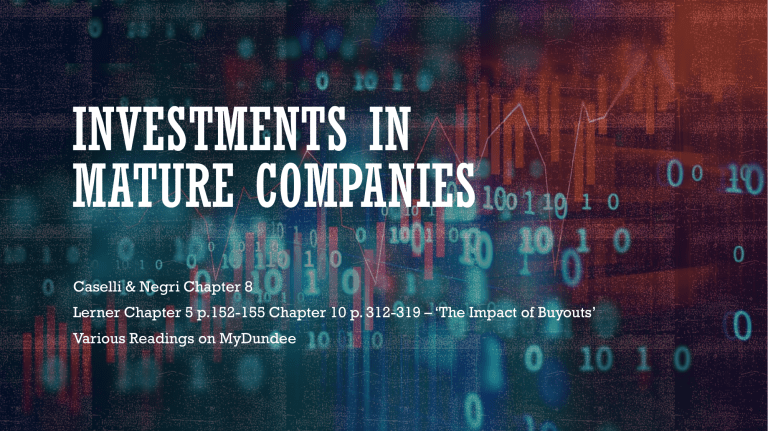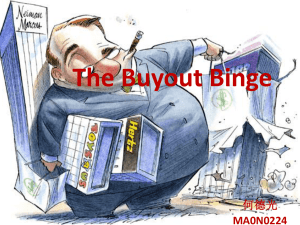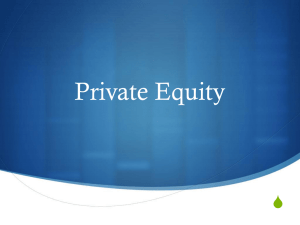
INVESTMENTS IN MATURE COMPANIES Caselli & Negri Chapter 8 Lerner Chapter 5 p.152-155 Chapter 10 p. 312-319 – ‘The Impact of Buyouts’ Various Readings on MyDundee This refers to deals by private equity firms in mature firms Accounts for nearly 70 percent (>65%) of amount invested by PE Firms Companies operate in challenging technological/competitive environment – may need to modify organisational structure otherwise these firms may not survive Usually when PE companies invest at this stage there are issues related to the organisational structure of the firms PIPE deals • • • • Private Investment in Public Equity Aim: To raise finance quickly shares are sold at a ‘discount’; minority stake. Stake must be big enough to make a potential buyer a majority shareholder (Basically, buying a stake in a company at a discount and then selling it at a premium to someone who wants a majority stake in the company (The stake should be big enough, so that it may be needed by anyone who wants a majority stake in the company) • Assuming that investors sell 10% of the daily trading volume after registration PIPE investors average a 21.2% return, compared to 4.9% for market investors over an average holding period of 384 days (Lim et. al, 2017) Turnaround deals • Can involve reengineering, restructuring and innovation • Management leadership and skill key to successful outcome • For example: Rutland Partners, Turnaround deal – Pizza Hut; and see also the case of the Edinburgh Woolen Mill THREE MAIN TYPES OF DEALS Buyouts Acquisition of a controlling interest in a company; can take the form of MBO/MBI etc. MBO (Management Buyout) – A transaction through which executives acquire a substantial stake in, and frequently control of a company they formerly managed. MBI (Management Buy-in) – A group of managers who have or believe they have the necessary skills to run a particular business and look around for a business to purchase BIMBO (Buy-in Management Buyout) – Hybrid; external and internal managers seeks control of a company LBO (Leveraged Buyout) – A buyout transactions that is primarily financed by debt In MBOs – Private equity firms acts as a sponsor provides equity finance leads negotiations with sellers Introduces syndicates of lenders to the deal Assets are used as a basis to fund the acquisition For example, Pizza Hut (UK) has been subject to a MBO ((see Pizza Hut completes management buyout after £60m turnaround (bighospitality.co.uk) Historically debt element has been 70-80% of the finance required (Typical structure 50-70% debt; and 50-30% equity) For a PE fund, the target rate of return is normally required to be 20% (Talmor & Vasvari, 2011) A new company is created (special purpose vehicle), is created to make the acquisition of the target company (the company subject to the buyout) The equity capital is provided to Newco by the private equity firm and the management team. Bank (loan) finance is used to part fund the purchase of the target and to provide working capital The security includes the bank finance is the target’s fixed assets, operating assets, book debts plus usually a charge from New Company The funding is only committed once the acquisition actually takes place EXAMPLE OF MBO Cost £100m Venture capital - £99.5m £35 m own equity £4.5m own debt £60m bank loan Management £0.5m (but get 10% of equity) 3 years of cost cutting and high performance Repayment of loans and stock market flotation Market value doubles to 200m Therefore, the management’s share now will be worth 20m, which means that they earned a return of 4000% on their initial investment of 0.5m FINANCIAL & GOVERNANCE STRUCTURE Debt brings tax deductible benefits; but the company must repay the interest (If poorly managed the company could go bankrupt & the employees lose their jobs) Outside directors may be replaced by directors appointed by PE firm (requires heavy involvement by management) These principle mechanisms are used to achieve success with LBOs 1. Management will aim to increase EBITDA through organic growth/improvement 2. Reduce debt and increase equity 3. Achieve highest exit multiple – exit when economy is in upturn or company is doing well (On average 5 years; typically, 3-7 years) Conditions for a good LBO: The company should be mature (Enough cash generated to repay the debts/strong brand name stable demand) Significant Assets (For collateral) Previous shareholders should be willing to sell their participations in the target company Company operations should guarantee that post buy out the company will improve after reducing debt costs Low leverage at the time of investment Strong Management Team SELLER MOTIVATED REASONS FOR MBO/MBI The parent company sells off peripheral activities to concentrate on its core business Geographic Location Small Size The operation may have been loss making Getting rid of the activity narrows the spread of business conserving management time 80% of the business – Requires 20% of managements time 20% of the business – Requires 80% of managements time The business may be worth more to another firm than its current owners May be the result of a strategic redirection by parent firm The parent may be having financial problems and selling off a business to raise cash Sell off to avoid publicity (Buyout is a preferred way as it is a private transaction and if the deal was to be done in a public setting it may lead to speculations that the company isn’t doing good) BUYER MOTIVATED REASONS FOR MBO/MBI Profit on flotation – especially disproportionate return for managerial investment Management can be lured by the entrepreneurial spirit Management may want to save jobs Sell off to someone else Closing Down Management believe they can run the business more efficiently Management may have insider knowledge of the company’s true potential Management may want to gain the benefits of private company status Less regulatory disclosures/reporting No need for an investor relations department STUDIES ON PERFORMANCE AND SHARE PRICE REACTION Kaplan (1989) One of the first to examine the performance of MBOs Sample of 48 US firms over 1980-85; average changes in their main measures examine Y0 = Year of buyout Results Y1 Y2 Y3 % % % -2.7 0.7 24.1 Capital expenditure -35.9 -32.6 -64.4 Cash flow 43.1 80.5 Operating profit 22.0 (Concern over the expenses reduction would be whether the reduction is due to the reduction of wasteful expenses or destruction of future value) Debt pre buyout 20.7% of total capital; after buyout 85.6% of total equity Emphasis on increasing cash flow Cutback on discretionary expenditure Kaplan also shows in a study of 25 MBOs Examined returns earned by shareholders at the time of MBO The mean return to shareholders of the parent at the time of MBO was 46.7%; with the average return positive for 100% of the sample Kaplan also analysed the return from the date of going private to the date of subsequent flotation Avg Return – 41.9% Positive returns for all the buyouts Avg time to flotation (going public) – 2.68 years In 12 of 76 buyouts (15.8%) the CEO leaves the firm. Only 37.5% of the buyout companies meet the projections they made the time of the buyout for yr 1 and 28% for the second full year In a related study, Kaplan (1989) concludes that while taxes are a source of value; buyouts created value in terms of operating efficiencies Relatively limited study; focuses on public-private buyouts; industry evolved since 1980s Per Stömberg looked at 21,397 PE transactions worldwide between 1970-2007 58% of buyout transactions exited more than 5 years after the initial transaction & only in 12% of the cases the exit is within two years UK study – 321 buyouts during 1995-2004 Average buyout company earned average of return on assets of 22.2% Management stake on average amounted to 37.6% On average the holding time was 3.5 years, with an average return on equity equal to 70.5% IPO exits outperform trade sales Larger managerial stakes associated with larger returns Larger buyouts perform better – as they have more than one business line while smaller companies are perhaps more susceptible to industry fluctuations Money plc is divesting one of its subsidiaries and the managers of the subsidiary have offered an attractive price of £20m subject to confirming a finance package with a venture capital provider (VC) and a bank. The finance package is as follows. QUESTION £m Equity from managers 2 Equity from VC 1 Mezzanine finance from VC 7 Senior debt from bank 10 20 What are the objectives facing the various parties (sellers, managers, venture capitalists and the bank), and how might they manage their specific risk?






